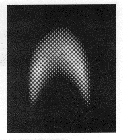
NASA Quantifies Soot Content of Flame Using Laser and Imaging Techniques

This report is NOT an endorsement by NASA or the Federal Government.
Laser-Induced Incandescence Quantifies Soot
Laser-Induced Incandescence (LII) is a laser-based
diagnostic technique for measuring the soot generated by a burning
fuel. In this case, a drop of fuel, approximately 1.5 mm in diameter,
is suspended from a bead on the end of a quartz optical fiber.
The fuel is ignited using a hot wire. Subsequent to ignition,
a sheet of light, formed from the 1064 nm beam of a pulsed Nd:YAG
laser, passes above the burning droplet and through the flame
center. The intense light heats any unburned particles (soot)
residing in the plume center to incandescent temperatures (near
4000 degrees Kelvin). A flame that generates a lot of soot produces
an incandescence signal of greater intensity because a higher
concentration of soot is heated by the laser. Independent experiments
have verified linearity between the LII signal and the soot volume
fraction (concentration). Determination of the soot volume fraction
in a flame is important since the soot volume fraction often controls
the radiative characteristics and temperature field of a flame.
Xybion Cameras
Two Xybion gated, intensified CCD cameras (Model
ISG-250), a 4MEG VIDEO Model 12 imaging board, and a VCR, capture
an image sequence of the burning process. The primary camera,
optimized for recording the LII signal, employs a UV lens preceded
by a 400 to 450 nm bandpass filter. The distance between the camera
and the flame is 30 cm. This camera is interfaced to a 4MEG VIDEO
Model 12 with 16 megabytes of image memory. The large image memory
allows capturing a sequence of LII images, obtained during the
burning of a single fuel droplet, with room to spare. Natural
flame images (unfiltered), from the second Xybion camera, are recorded on S-VHS video
tape .
4MEG VIDEO Model 12
Features of the 4MEG VIDEO Model 12 that are of particular
value in this experiment include its ability to synchronize to
the laser pulse, its ability to readily accommodate various sizes
of images, its ability to easily capture images with variable
frame rates, and its extensive image processing capabilities.
Most image processing requirements are satisfied by the standard
functions included in 4MIP menu driven software.
Custom Software with MIPX Scripts
Custom functions, generated with MIPX Scripts, were
written to provide custom arithmetic and filtering operations.
 Image of flame with random noise. |
 The same image after processing with a custom algorithm written using 4MIP software and MIPX Scripts. |
For example, an averaged object intensity was calculated for a sequence of images obtained from a single burning fuel droplet; this allowed comparison of the relative soot volume fraction produced by the droplet at different times during its burning history.
The unusual expansion chassis, which housed the Model 12, generated significant noise that displayed as random pixels with an intensity of 255 (see images above). EPIX engineers wrote a MIPX Script that applies a 4MIP speckle filter to all images in memory.
Note: This article was edited from NASA's original report entitled, "Laser-Induced Incandescence Applied to Droplet Combustion".
For further information about this experiment, including a more scientific (detailed) description of method and apparatus, please contact:
EPIX Vision - July 1994 Newsletter
Specifications and prices subject to change without notice.
EPIX® imaging products are made in the USA.
Copyright © 2025 EPIX, Inc. All rights reserved.